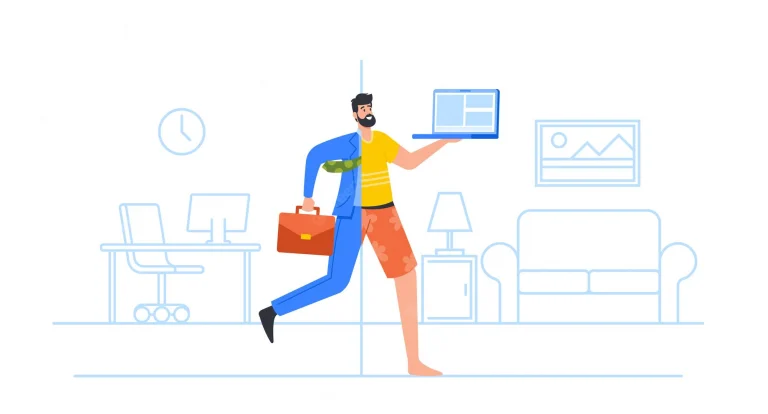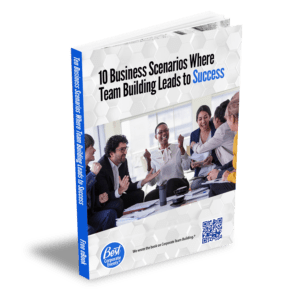With pandemic concerns receding, how should you structure your organization for the future of work: everyone back in the office, fully remote, or a hybrid approach? The latest research suggests that for enterprises focused on optimizing operational performance (i.e., pretty much everyone)—that’s the wrong question to ask.
Different employers are taking different approaches, and doing so successfully. There is no one-size-fits-all best model. There are pros and cons, for both workers and the organizations they work for, to every approach.
For employees, remote work offers greater flexibility, plus freedom from commuting and dressing in office attire. On the other hand, working remotely can make collaboration with coworkers more challenging, and lead to a sense of isolation. Research confirms that we humans are intensely social, and that isolation is bad for our happiness and emotional well-being.
For organizations, having workers in the office improves collaboration, provides opportunities for serendipitous brainstorming, and is vital for mentoring and developing younger employees. But a remote structure expands the talent pool because employers can hire workers based anywhere, while reducing the need for expensive office real estate.
Obviously, enterprises need to consider a wide range of factors in designing their workplace structure for the future. But what’s vital to keep in mind is that for optimizing performance, workplace structure isn’t the most important factor.
The key to maximizing productivity and effectiveness is improving employee engagement—and according to research from The Conference Board, “Work location—whether on-site, remote, or a hybrid blend of the two—has no impact on self-reported engagement levels.”
The Importance of Flexibility
Study after study identifies flexibility as one the most critical factors for increasing employee engagement.
According to Future Forum, “Flexibility improves work-life balance, decreases stress, and increases overall satisfaction.” Their research also found that:
- 80% of all knowledge workers now want flexibility in where they work.
- 94% of employees want flexibility in when they work (e.g., the freedom to deviate from a preset schedule).
- Employees with rigid work schedules and structures are three times more likely to look for a new job in the coming year.
Forbes echoes these findings. Reporting on studies from Gallup, McKinsey, and Kings College, the publication noted:
- Roughly one-third of employees would prefer to work remotely all or most of the time.
- Only about 10% want to go back to the office full time.
- 60 to 65% prefer a hybrid structure, with more than 50% wanting to work less than half-time in the office.
- 25% of respondents say they would quit if forced to return to the office full time.
Finally, the 2022 State of Talent Optimization Report from The Predictive Index concluded that:
- The number one driver of attrition is inflexibility.
- “Companies that prioritize the employee experience—whether through benefits, flexibility, inclusion, or a sense of purpose—see clear reductions in turnover compared to their peers.”
- Remote-friendly companies are experiencing 33% lower turnover.
These findings reflect our own experience. Roy Charette, managing partner at Best Corporate Events, and our team of facilitators and trainers work with hundreds of organizations and thousands of individual employees every year.
According to Roy, “In my experience over the past year and in talking with facilitators, people love working remotely—but when they have a chance to come together in person, they really enjoy the camaraderie and the ability to have face-to-face conversations instead of virtual discussions.
“People really feel that the ability to occasionally work remotely gives them better work-life balance. They don’t have to get all dressed up and jump in a car to fight traffic to get to work every day. There’s a blend that people are feeling, the sweet spot of some in-the-office and some remote work. That’s the ideal scenario for many people, combing remote work with getting together in person for key meetings and specific training.”
Flexibility is clearly a key component of engagement and retention. But that’s only part of the story.
The Impact of Personality
The statistics above reflect the average feelings of workers across large groups. But it’s vital not to lose sight of the individuals who make up these groups.
People with outgoing, highly social personalities crave more in-person interaction. Even those who don’t want to go back to the office completely full time still want a significant degree of in-person interaction.
Roy notes that his team of Best Corporate Events facilitators “love the interaction they have with participants when they are delivering team building programs. They even enjoy the travel, just getting out and about. When everything suddenly went virtual back in 2020, and that situation lasted, some of the facilitators actually experienced something like seasonal affective disorder.”
But other employees prefer to spend most of their time working remotely and alone. There are workers who are very efficient, effective individual contributors who don’t always work well collaboratively, because they are more introverted. They are talented, but less comfortable in social settings.
The challenge for leaders who want to build high-performing organizations is to create a high level of employee engagement—regardless of personality types or workplace structure.
The Role of Team Building
Not every employee wants the same workplace structure. And workers differ in the value they place on frequent social interaction. But (almost) every employee worth having enjoys:
- working collaboratively;
- solving problems;
- enhancing and expanding their own skills;
- helping others; and
- building relationships with coworkers.
All of those activities enhance employee engagement. And team building incorporates all of those elements.
Along with flexibility, employees value inclusiveness. The best team building programs are inclusive by design, with a variety of activities so that every team member can participate regardless of ability.
They are also designed to engage every participant—even those who may not be enthusiastic about being part of a team building exercise at the outset.
As Roy explains, “Some people will show up (and we see this a lot) with an attitude of ‘I’d rather be doing something else.’ But half an hour into the program, they love it. They’re having a blast along with everyone else.
“Some people arrive looking forward to the activity. Others will spend the first half hour making the facilitator ‘prove they can drive the bus’ before they will relax and enjoy the ride. Fortunately, one of the skills our facilitators have is that ability to prove themselves quickly, to open that door and break through any initial skepticism or emotional resistance.
“Our facilitators are used to that. They start with an icebreaker, then explain how the program will work, introduce the iPads, and then talk about the charity component if it’s a corporate social responsibility (CSR) program. Almost everyone is connected by that point. Even the folks who weren’t initially excited about being there start enjoying themselves very quickly.
“I and all of our trainers have been approached, time and again, by people during the break or after the program saying, ‘I really didn’t want to be here. I didn’t think I would enjoy this. But this was a blast.’”
How Professional Development Training Can Help
Teams are almost always a mix of different personality types. Keeping every member engaged and making the most of their talents requires the leadership ability to recognize these differences and adjust communication style accordingly.
Professional development programs like our DiSC Profile Workshop, Emotional Intelligence Training, and Myers-Briggs Type Indicator (MBTI) Training help leaders identify different personality types, build trust, and improve group communication.
Team Building and Flexibility
In large enterprises, employees often collaborate with team members in other offices as well as those working remotely. One benefit for organizations of the rise in remote work over the past few years is the ability to expand their talent pool.
Companies have realized that just because the headquarters is in Houston doesn’t mean they can’t hire a talented developer in Denver and an expert marketer in Minneapolis. In these environments, enterprises will often bring everyone together, physically, on a periodic basis: at least annually, sometimes bi-annually, or even quarterly.
Those events are not only great for presentations and group breakout sessions, but also for taking a break from the lecture or roundtable style meetings and doing something entirely new and different for a few hours in the middle of the two- or three-day offsite gathering.
“If they’re coming together live, chances are the meeting planner knows exactly what they’ve done before, because meeting planners are really good about asking the right questions,” says Roy.
- How well do the members of the group know each other?
- How often do they get together?
- How much time do we have?
- How large is the group?
- What other team building events have they done in the past?
- What have they tried, if anything, that didn’t work?
- What have they tried that has worked great?
“With all of that information, we can recommend a program that will be a wonderful fit,” adds Roy. “For example, we’ll introduce an activity like Pipeline or Competition to Collaboration® that is initially fun and competitive, then ultimately becomes collaborative.
“Our Bridge to the Future program is a great visual metaphor for the goals and aspirations of the organization, and for individual teams moving forward. The bridge theme is very powerful because the organization is bridging the gap between the prior year or period and what they want to achieve in the coming period and beyond.”
Team building programs can also be delivered flexibly, as in-person, virtual, or hybrid events. Professional development programs like Developing Emerging Leaders and Strategic Leadership combine an initial in-person workshop with a series of online sessions over several weeks.
Conclusion
As organizations balance competing priorities in developing their workplace structures of the future—remote, in-office, or a hybrid combination—there’s a strong link between employee retention and flexibility.
What matters most for developing a high-performing operation, however, is employee engagement. And research shows that engagement has essentially no relationship to work location.
Flexibility is one important component. But others include inclusivity, sense of purpose, workplace relationships, and leadership. Team building supports all of those elements.
Professional development programs help leaders to better understand different personality types and the role emotion plays in team dynamics, and improve communication with and among team members to help optimize performance.
Incorporating team building programs within all-company offsite meetings helps build relationships, improve collaboration, and enhance employee engagement. Fun, challenging team building activities can win over skeptics to create emotionally powerful shared experiences.


